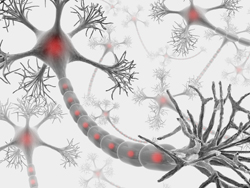Myelin in health and disease
Myelin serves an important function in the nervous system by insulating the transmission of electrochemical signals down neuronal axons that transmit information to muscles, glands and other neurons. The cells responsible for myelin production are the Schwann and glial cells, through their molecular interaction with the neurons. Understanding the mechanisms underlying this cellular interplay could prove vital for treating myelin disorders. The EU-funded 'Neuron-glia interactions in nerve development and disease' (NGIDD) project investigated the engagement of axons and glial cells, the control of myelin production and the pathology associated with its absence. The ultimate goal was to identify new drug targets to stimulate the regenerative capacity of the nervous system. Scientists unveiled the importance of the Schwann cell-derived protein Lgi4 and its axonal receptor Adam22 in maintaining myelin formation, alongside various integrins, focal adhesion kinase and N-WASP. Taken together, these findings indicated that actin filaments controlling cell shape are central to axon–glial cell interaction. Further RNA interference work in the fruit fly Drosophila melanogaster aimed to unravel most of the genes required for glial differentiation. Given that the functional organisation of the axo-glial unit is evolutionarily conserved, partners aim to extrapolate their findings to humans. In order to explore various therapeutic interventions, NGIDD partners developed mouse models of neuropathies (such as mTOR signalling or c-jun knockout) and identified rapamycin as a beneficial modulator of myelin abnormalities. Combined with a cell-based assay for drug screening, scientists envisioned a high-throughput system for identifying therapeutic compounds and using them for myelin regeneration. By investigating normal nerve development, the NGIDD consortium wished to apply its results to inherited neuropathies. Most of the mechanisms implicated in the formation of functional myelinated fibres are repeated during repair and could therefore be exploited for therapeutic purposes.







